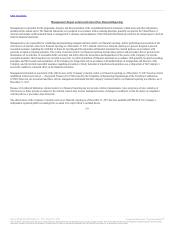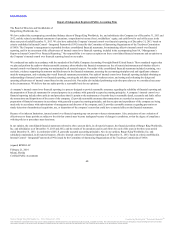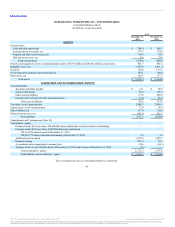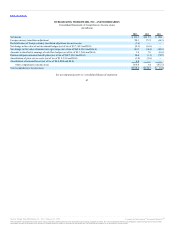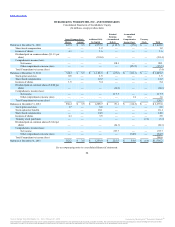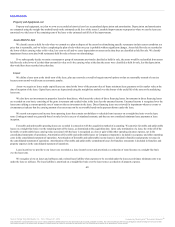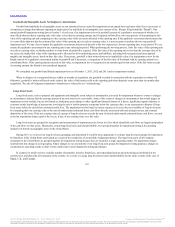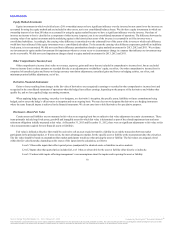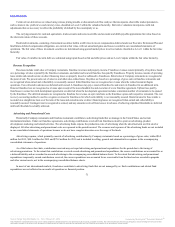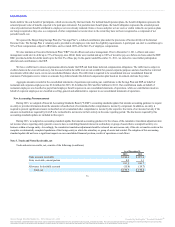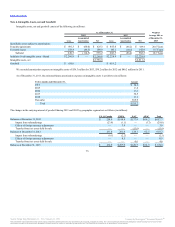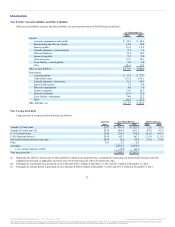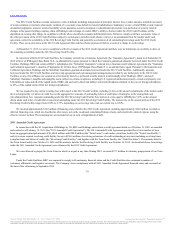Burger King 2013 Annual Report Download - page 71
Download and view the complete annual report
Please find page 71 of the 2013 Burger King annual report below. You can navigate through the pages in the report by either clicking on the pages listed below, or by using the keyword search tool below to find specific information within the annual report.
Table of Contents
Goodwill and indefinite-lived intangible assets are not amortized, but are tested for impairment on an annual basis and more often if an event occurs or
circumstances change that indicates impairment might exist. Our indefinite-lived intangible asset consists of the Burger King brand (the “Brand”). Our
annual goodwill impairment testing date is October 1 of each year. Our impairment review for goodwill consists of a qualitative assessment of whether it is
more-likely-than-not that a reporting unit’s fair value is less than its carrying amount, and if required, followed by a two-step process of determining the fair
value of the reporting unit and comparing it to the carrying value of the net assets allocated to the reporting unit. If the qualitative assessment demonstrates that
it is more-likely-than-not that the estimated fair value of the reporting unit exceeds its carrying value, it is not necessary to perform the two-step goodwill
impairment test. We may elect to bypass the qualitative assessment and proceed directly to the two-step process, for any reporting unit, in any period. We can
resume the qualitative assessment for any reporting unit in any subsequent period. When performing the two-step process, if the fair value of the reporting unit
exceeds its carrying value, no further analysis or write-down of goodwill is required. If the fair value of the reporting unit is less than the carrying value of its
net assets, the implied fair value of the reporting unit is allocated to all its underlying assets and liabilities, including both recognized and unrecognized
tangible and intangible assets, based on their fair value. If necessary, goodwill is then written down to its implied fair value. Our impairment review for the
Brand consists of a qualitative assessment similar to goodwill and if necessary, a comparison of the fair value of the Brand with its carrying amount on a
consolidated basis. If the carrying amount exceeds its fair value, an impairment loss is recognized in an amount equal to that excess. If the fair value exceeds
its carrying amount, the Brand is not considered impaired.
We completed our goodwill and Brand impairment tests as of October 1, 2013, 2012 and 2011 and no impairment resulted.
When we dispose of a restaurant business within six months of acquisition, the goodwill recorded in connection with the acquisition is written off.
Otherwise, goodwill is written off based on the relative fair value of the business sold to the reporting unit when disposals occur more than six months after
acquisition. The sale of Company restaurants to franchisees is referred to as a “refranchising.”
Long-lived assets, such as property and equipment and intangible assets subject to amortization, are tested for impairment whenever events or changes
in circumstances indicate that the carrying amount of an asset may not be recoverable. Some of the events or changes in circumstances that would trigger an
impairment review include, but are not limited to, bankruptcy proceedings or other significant financial distress of a lessee; significant negative industry or
economic trends; knowledge of transactions involving the sale of similar property at amounts below the carrying value; or our expectation to dispose of long-
lived assets before the end of their estimated useful lives. The impairment test for long-lived assets requires us to assess the recoverability of long-lived assets
by comparing their net carrying value to the sum of undiscounted estimated future cash flows directly associated with and arising from use and eventual
disposition of the assets. If the net carrying value of a group of long-lived assets exceeds the sum of related undiscounted estimated future cash flows, we must
record an impairment charge equal to the excess, if any, of net carrying value over fair value.
Long-lived assets are grouped for recognition and measurement of impairment at the lowest level for which identifiable cash flows are largely independent
of the cash flows of other assets. Historically, certain long-lived assets and related liabilities were grouped together for impairment testing at the operating
market level (based on geographic areas) in the United States.
During 2013, we reviewed our long-lived asset groupings and determined it would be more appropriate to evaluate long-lived asset groups for impairment
by franchisee in the United States and Canada as a result of the completion of our portfolio realignment project. The long-lived assets of all Company
restaurants in the United States are grouped together for impairment testing because they are located in a single operating market. No impairment charges
resulted from this change in asset grouping. Future changes to our assessments of our long-lived asset groups for impairment testing purposes, changes in
circumstances, operating results or other events could result in asset impairment testing and charges.
In countries in which we have a smaller number of properties leased to franchisees, most operating functions and advertising are performed at the
country level, and shared by all restaurants in the country. As a result, we group long-lived assets and related liabilities for the entire country in the case of
Spain, U.K. and Canada.
69
Source: Burger King Worldwide, Inc., 10-K, February 21, 2014 Powered by Morningstar® Document Research℠
The information contained herein may not be copied, adapted or distributed and is not warranted to be accurate, complete or timely. The user assumes all risks for any damages or losses arising from any use of this
information, except to the extent such damages or losses cannot be limited or excluded by applicable law. Past financial performance is no guarantee of future results.


